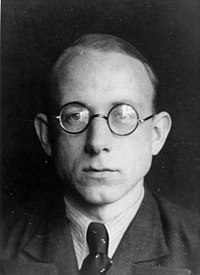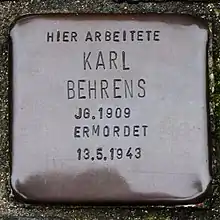Karl Behrens
Karl Behrens (* 18 November 1909 in Kreuzberg, Berlin; † 13 May 1943 in Plötzensee Prison)[1] was a design engineer and resistance fighter against Nazism.[2] Behrens was most notable for being was a member of the Berlin-based anti-fascist resistance group, that was later called the Red Orchestra by the Abwehr. Behrens acted as a courier for the group, passing reports between Arvid Harnack and Hans Coppi who was the radioman.[3] Behrens was also active is a resistance group at the AEG turbine factory power together with Walter Homann and others.
Karl Behrens | |
|---|---|
 Karl Behrens in 1943 | |
| Born | November 18, 1909 |
| Died | May 13, 1943 (aged 33) |
| Nationality | German |
| Occupation | Tool maker |
| Known for | Member of the Red Orchestra |
Life

Behrens came from a working class family.[2] Behrens completed a locksmith apprenticeship and then became unemployed. Coming from the Boy Scouts, he joined the Sturmabteilung in 1929 and joined the Nazi Party.[1] In April 1931, he was expelled from the party for supporting Walther Stennes[4] in his attempted coup against Hitler, in what became known as the Stennes Revolt. In 1931, he temporarily joined Otto Strasser's Black Front before moving to join the Communist Party of Germany(KPD) at the end of 1932. From 1932, he attended the Berlin Abendgymnasium (Evening Grammar School) where he achieved the Abitur from the Berlin Abendgymnasium and then went on to study mechanical engineering[2] at the Beuth School in Wedding, now known as the Beuth University of Applied Sciences Berlin. At the Berlin Abendgymnasium, he met the American Mildred Harnack, who taught English.[5] Behrens joined the oppositional discussion circle around her husband Arvid Harnack.[5] In 1938, Behrens began working as a design engineer at the giant AEG turbine factory.[1] Behrens became one of Arvid Harnack's closest comrades-in-arms in the resistance.[6]
He provided political, economic and military information to the Soviet People's Commissariat for State Security (NKGB), where he was assigned the code name, Lutschisti (Shining One, Ray of Light or Beamer).[7][8]
In February 1939, Behrens married Clara Behrens née Sonnenschmidt, a stenotypist in the OKH[9] and they had two sons and a daughter together.[1]
Arvid Harnack therefore decides in 1941 not to use Behrens as a radio operator for a planned connection with the Soviet Union. He is said to have forwarded encrypted messages from Arvid Harnack to Hans Coppi a few times.[3]
In the same year, Behrens was arrested for forging exit papers for his Jewish brother-in-law, Charly Fischer.[10] Fischer was eventually captured and was executed at Sachsenhausen concentration camp.[10]
Arrest
On May 1942, Behrens was drafted into the artillery. He was arrested on 16 September 1942 on the Eastern Front outside Saint Petersburg, then Leningrad. On 20 January 1943, he is sentenced to death by the Reichskriegsgericht and executed in Plötzensee Prison. His wife Clare Behrens survived the war and became a tailor.
Literature
- Regina Griebel, Marlies Coburger, Heinrich Scheel, Gedenkstätte der Deutscher Widerstand Berlin (Germany), Senatsverwaltung für Kulturelle Angelegenheiten Germany, Geheime Staatspolizei. (1992). Erfasst? : das Gestapo-Album zur Roten Kapelle : eine Foto-Dokumentation (in German). Halle/S.: Audioscop. ISBN 9783883840444. OCLC 29316949.CS1 maint: uses authors parameter (link)
- Oleschinski, Brigitte (2002). Gedenkstätte Plötzensee (in German). Berlin: Gedenkstätte Deutscher Widerstand. ISBN 9783926082053. OCLC 254638886.
- Rosiejka, Gert (1986). Die Rote Kapelle "Landesverrat" als antifaschist. Widerstand. Ergebnisse, 33 (in German) (1st ed.). Hamburg: Ergebnisse-Verlag. ISBN 9783925622168. OCLC 74741321.
- Kraushaar, Luise (1970). Deutsche Widerstandskämpfer 1933–1945. Biographien und Briefe. 1. Berlin: Dietz. pp. 98–101.
- Juchler, Ingo (2017). Mildred Harnack und die Rote Kapelle in Berlin (in German) (1st ed.). Potsdam: Universitäts verlag. ISBN 978-3-86956-407-4. OCLC 1009082138.
Awards and Honors
- On 6 October 1969, he was posthumously awarded the Order of the Patriotic War First Class by the Soviet Union.[11]
- On 18 November 2009, a commemorative plaque was dedicated by the Friedrichshain-Kreuzberg district office at Karl Behrens' former home at 22 Yorckstraße (corner house to 91 Möckernstraße).
- Karl Behrens is honoured with a stumbling stone at 12 Huttenstraße in Moabit, Berlin
References
- "Karl Behrens". Stolpersteine in Berlin (in German). Koordinierungsstelle Stolpersteine Berlin. Retrieved 20 December 2020.
- "Karl Behrens". Gedenkstätte Deutscher Widerstand (in German). German Resistance Memorial Center. Retrieved 20 December 2020.
- Kesaris, Paul. L, ed. (1979). The Rote Kapelle: the CIA's history of Soviet intelligence and espionage networks in Western Europe, 1936-1945 (pdf). Washington DC: University Publications of America. p. 150. ISBN 978-0-89093-203-2.
- Juchler, Ingo; Ambauen, Ladina; Arnold, Maren (25 October 2017). Mildred Harnack und die Rote Kapelle in Berlin (in German). Universitätsverlag Potsdam. p. 113. ISBN 978-3-86956-407-4. Retrieved 22 December 2020.
- Brysac, Shareen Blair (2000). Resisting Hitler: Mildred Harnack and the Red Orchestra. Oxford University Press. p. 147. ISBN 978-0-19-992388-5. Retrieved 26 December 2018. Lay summary.
- Brysac, Shareen Blair (2000). Resisting Hitler: Mildred Harnack and the Red Orchestra. Oxford University Press. p. 247. ISBN 978-0-19-992388-5. Retrieved 26 December 2018. Lay summary.
- Juchler, Ingo; Ambauen, Ladina; Arnold, Maren (25 October 2017). Mildred Harnack und die Rote Kapelle in Berlin (in German). Universitätsverlag Potsdam. p. 114. ISBN 978-3-86956-407-4. Retrieved 22 December 2020.
- Nelson, Anne (7 April 2009). Red Orchestra: The Story of the Berlin Underground and the Circle of Friends Who Resisted Hitle r. Random House Publishing Group. p. 190. ISBN 978-1-58836-799-0. Retrieved 22 December 2020.
- Brysac, Shareen Blair (2000). Resisting Hitler: Mildred Harnack and the Red Orchestra. Oxford University Press. p. 272. ISBN 978-0-19-992388-5. Retrieved 26 December 2018. Lay summary.
- Brysac, Shareen Blair (2000). Resisting Hitler: Mildred Harnack and the Red Orchestra. Oxford University Press. p. 245. ISBN 978-0-19-992388-5. Retrieved 26 December 2018. Lay summary.
- "Ausgezeichnet postum mit dem Orden des Vaterlandischen Krieges Erster Stufe". Neues Deutschland Druckerei und Verlags GmbH. Neues Deutschland. 23 December 1969. p. 4. Retrieved 22 December 2020.